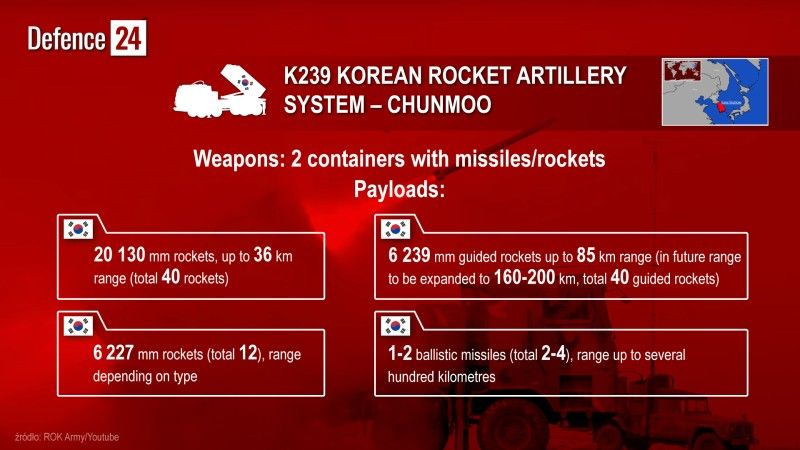Korean K239 Rocket Artillery System – New Developments Between Korea and Poland

Polish-Korean talks on procurement of a new rocket artillery system have gained significant momentum, Defence24.pl found out. Warsaw is seriously considering the acquisition of the Korean-made K239 Chunmoo rocket artillery solution. Its capabilities are somewhat on par with the US-made HIMARS systems already procured by Poland - another letter of request for the HIMARS system has been placed. However, the procurement of the Korean system would also include broad industrial cooperation.
Talks on other areas of defence cooperation between Poland and Korea have been overshadowed by the procurements of the K2 MBTs, K9 howitzers, and light FA-50 combat aircraft. One of those overshadowed matters pertains to rocket artillery. Poland has communicated demand for almost 500 M142 HIMARS systems to the US. However, it remains unclear whether the Americans would be able to fully meet that demand across a short enough timeline, given the fact that the US military is also seeking options to increase the inventory of MLRS-class assets.
Thus, the Polish Ministry of Defence has gotten itself engaged in talks on the procurement of extra rocket artillery systems from the Republic of Korea. The above refers to the K239 Chunmoo already commissioned in the South Korean Army which also operates the US-made M270A0/A1 MLRS solution on a tracked platform. The off-the-record information that we have obtained suggests that the Polish-Korean talks have gained much momentum recently and that the acquisition of the South Korean part of the Homar system is more and more probable, but no final decisions have been made just yet.
K239 Chunmoo System Overview
The K239 Chunmoo has been developed to replace the obsolete K136 Kooryong assets and significantly improve the capabilities available at hand. The 130 mm rockets allowed the K136 systems to attack targets at a distance of 23 to 36 kilometers, with the whole launcher carrying 36 rockets. The relevant development project has been launched domestically in 2009. 4 years later the Korean Defense Agency for Technology and Quality allocated USD 112.4 million to develop a replacement for the Kooryong solution. This resulted in the project being significantly accelerated. As a result, series manufacturing was launched. The first lot was to include 58 systems. Ultimately the ROKAF is to operate more than 350 platforms as such.
The K239 Chunmoo is a self-propelled, wheeled multiple rocket launch system that can launch rockets of varied calibers (130 mm, 227 mm, 239 mm). It can also launch tactical ballistic missiles. The launcher features two launch containers. According to the publicly available data, each of these containers can accommodate several effector types.
- Twenty 130 mm K33 unguided rockets, with a range of 36 kilometers (40 in total);
- Six 227 mm KM26A2 rockets, manufactured based on a US-granted license and derived from the M270A0 MLRS effectors - with these systems also being used by South Korea; these rockets offer a range of 45 kilometers
- Six guided 239 mm rockets, with a range of 80-85 kilometers (12 in total); works are underway aimed at the development of a new generation of those missiles, with ranges increased to 160-200 kilometers
- 1 or 2 ballistic missiles with a range of up to several hundred kilometers, with calibers of 600 or 400 mm.
It remains unclear whether the variant capable of launching the ballistic missiles has already been fielded in the Korean military.
The K239 system rockets can use HE-frag, incendiary, smoke, illuminating, cluster, anti-tank, or pre-fragmented warheads. Defense News recently reported that works are underway, aimed at creating enhanced 239 mm rockets, with a range increased from 80-85 kilometers to 160-200 kilometers. This would gradually increase the K239's firepower. The system is being developed in a manner that is continuous and consistent.
GPS/INS-guided 239 mm rockets feature fuses that offer dual mode - they can detonate on impact, or with a delay. The Republic of Korea Army wanted the guided rocket to feature a penetrator bunker-buster warhead.
The system has been based on a Hanwha 8x8 truck with an armored cabin, protecting the crew from small arms fire, or artillery shell fragmentation. The combat weight is defined as 25-30 tonnes, the range is 800 kilometers, and the vehicle can travel at a top speed of 90 kph. Every Chunmoo system is supported by an ammunition carrier using the very same truck type, featuring four reloading containers. The reloading system is highly automated, similarly to MLRS/HIMARS, granting the platform the ability to rapidly recover its combat readiness.
The information we have received suggests that the potential acquisition of the Korean system would also involve broad industrial cooperation. Not only would that mean that Polish Jelcz vehicles and Topaz FCS/BMS would be used, but license-manufacturing of the rockets may also be the case.
Notably, the Korean system is also highly modular. It can launch both Korean rockets (130 mm, 239 mm), as well as the US-made ones (it is certain to use the KM-26M2 rockets that are a license-manufactured version of the US-made M26A2 MLRS rockets). One of the possible directions of future development could include an extension of the range of the 239 mm guided rockets, and the commissioning of ballistic missiles - however, the reports on the use of those have been conflicting.
Another potential development could involve the integration of more effectors, and further rockets, such as the US-made GMLRS for HIMARS compatibility, or the 122 mm rockets used in the Polish Langusta solution. Given the fact that the system uses 130 mm rockets similar to ones used in Langusta, along with 227 mm unguided rockets, this seems possible from a technical standpoint. It would only require the consent of Korean and Polish parties (for the 122 mm rockets), of the US side (for GMLRS), and the development of proper launch containers. A solution as such would be favorable from the operational point of view.
Adam Świerkowski, Jakub Palowski

WIDEO: Defence24 Days 2025: Premier Defence & Security Conference in CEE